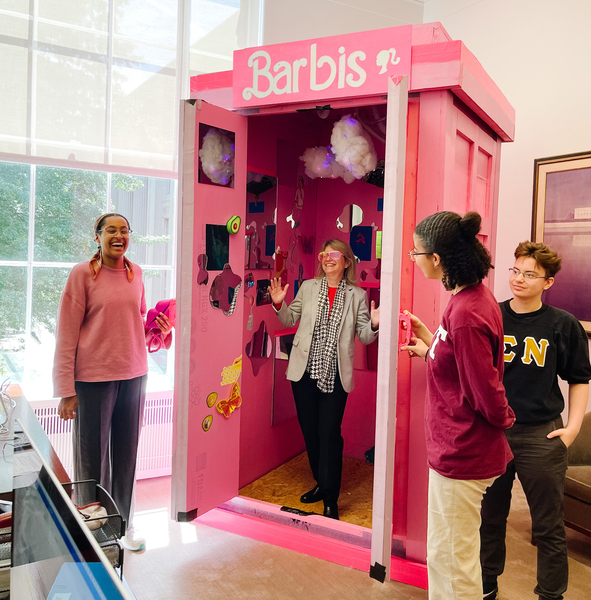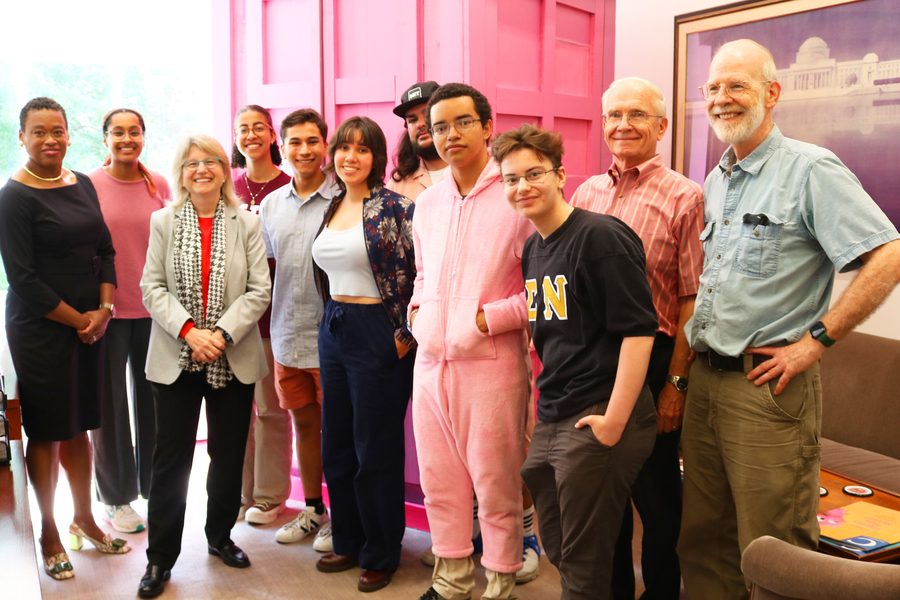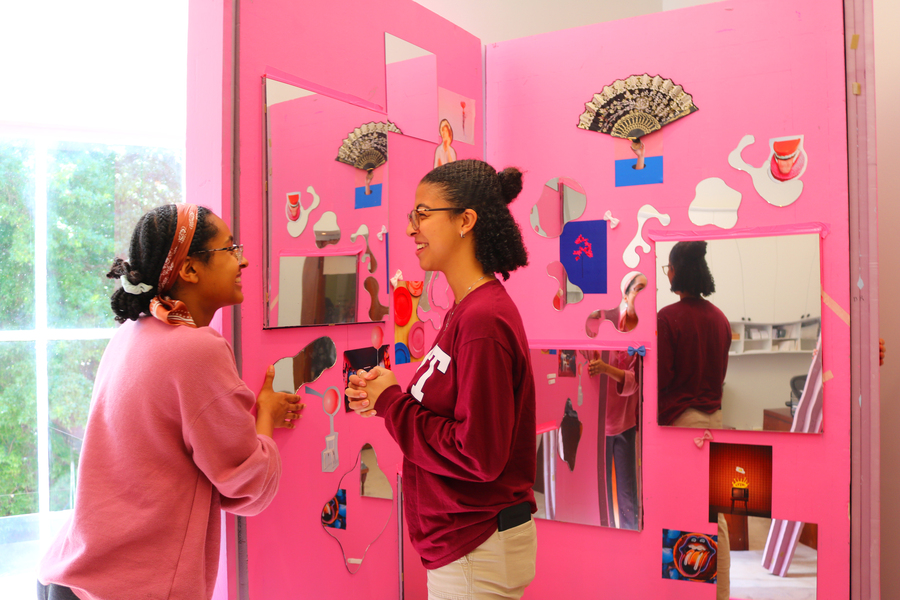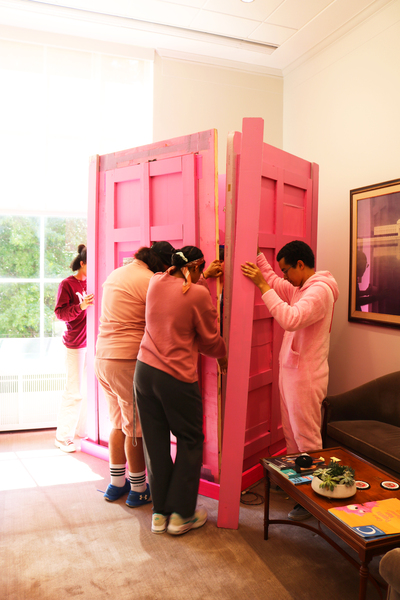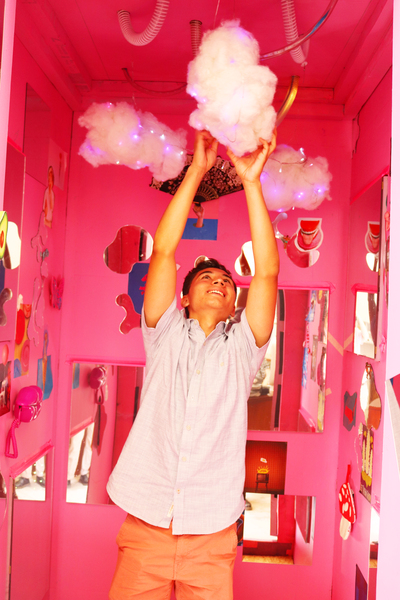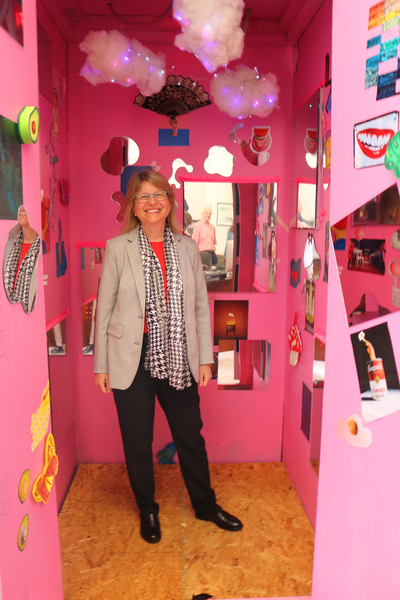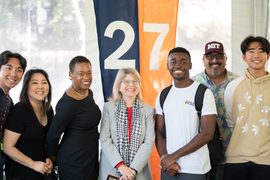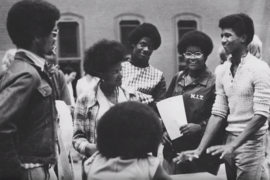On the first day of fall class registration, MIT President Sally Kornbluth entered her office to find a life-sized Barbie-themed phone booth sitting in the reception area.
Intrigued, she opened the pink phone booth door and stepped inside, where she discovered a complex web of mirrors and lights that give the illusion of infinite space travel.
After enjoying a good laugh, she was greeted by the six incoming first-year students behind the project. “This exemplifies the creativity, the innovation, and the technical know-how of MIT students and I’m amazed they created this in their first hour [as undergraduates],” Kornbluth shared. “They’ve already internalized the real vibe of MIT.”
“Barbis” consists of four walls constructed from polystyrene that are embedded with two infinity mirrors each, a roof, and a floor. “The hardest part of this project, and the feature we’re proudest of, is that the entire structure can be completely disassembled and quickly reassembled,” says Huda Abdelghani, one of the project’s student creators.
“The new ‘Barbie’ movie sparked a massive cultural phenomenon,” shares first-year Diego Del Rio. “This brought attention to the problematic history associated with Mattel's creation of Barbie dolls. On the outside, ‘Barbis’ appears as an imposing structure, a box filled with society's beauty expectations and pressures. Stepping inside, however, our goal was to disrupt this narrative.”
The team challenged Mattel’s beauty standards by merging Barbie with the concept of the TARDIS, a time- and space-traveling vehicle in the shape of a British police call box that appears in the “Doctor Who” television series. “Similar to how the image propagated by Mattel has spanned across time and space, teaching young girls and other users around the world that this specific image is the epitome of beauty,” Del Rio explains.
Del Rio discovered a talent for computer science when he taught himself how to code the circuit for the intricate web of lights. The infinity mirror is composed of an opaque mirror and a two-way mirror. In between the two mirrors there are strips of LED lights. As the light bounces between the mirror, small amounts of light are let through, which allows us to see a light tunnel traveling to infinity.
“Mirrors symbolize self-reflection; they remind us that the power to challenge societal norms rests with the viewers — the consumers of media — rather than those who shape it,” Del Rio says. “Lights, too, reinforce this notion by creating an environment that illuminates and empowers. The infinity element signifies that without active intervention to change this corporate-driven stigma, the cycle of perpetuating an unattainable beauty standard will persist across time and space. The experience fosters a sense of empowerment, encouraging all to contribute to dismantling these ingrained beauty standards and embrace the inherent beauty that resides within us all.”
Barbis was constructed during an eight-week course at the MIT Edgerton Center, in collaboration with the Office of Minority Education, as part of the Interphase EDGE/x program, in which students self-divide into project teams and envision and complete a project, while gaining hands-on engineering skills and making new friends.
“An essential part of the MIT education is imagination and creativity,” says Edgerton instructor Ed Moriarty. “We need to be able to imagine the better world before we can build it.” The Edgerton Center’s approach to education is based on its namesake, the late Harold “Doc” Edgerton, who, believing in the irreplaceable need for hands-on learning experiences for students, once said, “The trick to education is to teach people in such a way that they don't realize they're learning until it's too late."
Accordingly, each student took away their own lessons from building Barbis.
“I draw a lot of Barbis's meaning, personally, to how her building process felt,” shares first-year Amber Brown. “I felt like the entire time it was ever-changing. It was constantly evolving. And I remember early in the project, I said ‘every time someone says, “what if,” I want to die, because I know I'm going to have to redesign everything.’ And I feel like that's reflective of pretty much the country as a whole, or every issue that we're ever challenged with. Every time that there is a problem, and you have to solve it, you have to solve it by almost always complete redesign of the issue. And the complete redesign is like an overhaul that people are afraid of, or people don't want to engage in. I could feel that fear myself. Now when I go out into the world and I see people with similar issues, whether it be lawmakers or engineers, I understand their fear as well, because I have been in that position.”
Del Rio hopes that Barbis’s meaning is applied in a broader perspective as well. “I think there are so many issues in modern day society that have been taken as facts, and that I think that everyone needs to continuously question whether it’s the system of government that we have in the United States, whether we have the racial injustice that is embedded into our society, whether it’s like the gender and the beauty standard. I think that people really do need to challenge the system,” Del Rio says.
For first-year Isa Ortiz, Barbis represents hope. “Where I came from, there would have been no place where I would have had an opportunity like this to just work on a project that I enjoy, or to try something new,” Ortiz shares. “The Edgerton Center puts a lot of faith in us because we had never really done this before. Even when we weren't confident in ourselves, the Edgerton Center staff were confident in us, like we could do it. And because of that, I felt like we could do anything.”
